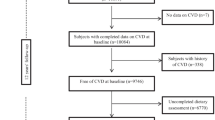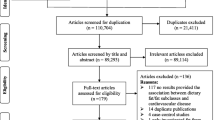Abstract
Objectives
To examine the association between a dietary fat quality index (FQI), and the risk of incident cardiovascular events or deaths in the Seguimiento Universidad de Navarra (SUN) cohort.
Design
Longitudinal analysis during 10.1 years of median follow-up. Cox models were used to estimate adjusted hazard ratios (HR) of incident cardiovascular diseases (CVD) according to tertiles of FQI and of different fat subtypes.
Setting
University of Navarra, Spain.
Participants
19,341 middle-aged adults.
Measurements
Fat intake was measured with a validated food-frequency questionnaire. The FQI was calculated according to the ratio: (monounsaturated+polyunsaturated) / (saturated+trans fatty acids).
Results
We observed 140 incident cases of CVD. No association was found for FQI (HR=0.94, 95 %CI 0.61–1.47 for the highest vs the lowest tertile, p for trend=0.884). No significant associations were found for different dietary fat subtypes on CVD risk. The results suggest no clear association between a higher FQI and a higher amount of energy from fat and incidence of CVD (p for interaction: 0.259 and p for trend only among participants with a percentage of energy from fat ≥35% of total energy: 0.272).
Conclusion
In this Mediterranean cohort, the FQI was not associated with cardiovascular events. A “heart-healthy diet” should focus its attention on dietary fat sources and should use an overall dietary pattern approach, rather than limiting the focus on fat subtypes. More research is needed to validate dietary advice on specific fatty acids intake or saturated fatty acids replacements for reducing CVD risk.





Similar content being viewed by others
Abbreviations
- BMI:
-
body mass index
- CI:
-
confidence interval
- CVD:
-
cardiovascular disease
- FFQ:
-
food frequency questionnaire
- FQI:
-
fat quality index
- HR:
-
hazard ratio
- MET:
-
metabolic equivalent index
- MUFA:
-
monounsaturated fatty acids
- PUFA:
-
polyunsaturated fatty acids
- SD:
-
standard deviation
- SFA:
-
saturated fatty acids
- SUN:
-
Seguimiento Universidad de Navarra Follow-up University of Navarra
- TFA:
-
trans fatty acids
References
Menotti A, Puddu PE, Lanti M, Maiani G, Catasta G, Fidanza AA. Lifestyle habits and mortality from all and specific causes of death: 40-year follow-up in the Italian Rural Areas of the Seven Countries Study. J Nutr Health Aging. 2014;18(3):314–21.
World Health Organization..Global status report on noncommunicable diseases; 2014.
Dalen JE, Devries S. Diets to prevent coronary heart disease 1957–2013: what have we learned? Am J Med. 2014; 127:364–9.
Martinez-Gonzalez MA, Bes-Rastrollo M. Dietary patterns, Mediterranean diet, and cardiovascular disease. Curr Opin Lipidol. 2014; 25:20–6.
Chan R, Chan D, Woo J. The association of a priori and a posterior dietary patterns with the risk of incident stroke in Chinese older people in Hong Kong. J Nutr Health Aging. 2013;17(10):866–74.
Misciagna G, Del Pilar Díaz M, Caramia DV, Bonfiglio C, Franco I, Noviello MR, et al. Effect of a Low Glycemic Index Mediterranean Diet on Non-Alcoholic Fatty Liver Disease. A Randomized Controlled Clinici Trial. J Nutr Health Aging. 2017;21(4):404–412.
Widmer RJ, Flammer AJ, Lerman LO, Lerman A. The Mediterranean Diet, its Components, and Cardiovascular Disease. Am J Med 2015; 128:229–38.
Mozaffarian D. Dietary and Policy Priorities for Cardiovascular Disease, Diabetes, and Obesity: A Comprehensive Review. Circulation 2016; 133:187–225.
Eckel RH, Jakicic JM, Ard JD, de Jesus JM, Houston Miller N, Hubbard VS, et al. 2013 AHA/ACC guideline on lifestyle management to reduce cardiovascular risk: a report of the American College of Cardiology/American Heart Association Task Force on Practice Guidelines. Circulation 2014; 129:S76–99.
Schwab U, Uusitupa M. Diet heart controversies—Quality of fat matters. Nutr Metab Cardiovasc Dis. 2015; 25:617–22.
Schwab U, Lauritzen L, Tholstrup T, Haldorssoni T, Riserus U, Uusitupa M, et al. Effect of the amount and type of dietary fat on cardiometabolic risk factors and risk of developing type 2 diabetes, cardiovascular diseases, and cancer: a systematic review. Food Nutr Res. 2014; 58.
Hammad S, Pu S, Jones PJ. Current Evidence Supporting the Link Between Dietary Fatty Acids and Cardiovascular Disease. Lipids. 2016; 51:507–17.
Hooper L, Martin N, Abdelhamid A, Davey Smith G. Reduction in saturated fat intake for cardiovascular disease. Cochrane Database Syst Rev. 2015:CD011737.
Guasch-Ferre M, Babio N, Martinez-Gonzalez MA, Corella D, Ros E, Martin-Pelaez S, et al. Dietary fat intake and risk of cardiovascular disease and all-cause mortality in a population at high risk of cardiovascular disease. Am J Clin Nutr. 2015; 102:1563–73.
Nettleton JA, Lovegrove JA, Mensink RP, Schwab U. Dietary Fatty Acids: Is it Time to Change the Recommendations? Ann Nutr Metab. 2016;68:249–57.
Ramsden CE, Zamora D, Majchrzak-Hong S, Faurot KR, Broste SK, Frantz RP, et al. Re-evaluation of the traditional diet-heart hypothesis: analysis of recovered data from Minnesota Coronary Experiment (1968–73). BMJ. 2016; 353:i1246.
Barbieiri P, Nunes JC, Torres AG, Nishimura RY, Zuccolotto DC, Crivellenti LC, Franco LJ, Sartorelli DS. Indices of dietary fat quality during midpregnancy is associated with gestational diabetes. Nutrition. 2016 Jun;32:656–61.
Chiuve SE, Rimm EB, Sandhu RK, Bernstein AM, Rexrode KM, Manson JEet al. Dietary fat quality and risk of sudden cardiac death in women. Am J Clin Nutr. 2012 Sep;96:498–507.
Segui-Gomez M, de la Fuente C, Vazquez Z, de Irala J, Martinez-Gonzalez MA. Cohort profile: the ‘Seguimiento Universidad de Navarra’ (SUN) study. Int J Epidemiol. 2006; 35:1417–22.
Martin-Moreno JM, Boyle P, Gorgojo L, Maisonneuve P, Fernandez-Rodriguez JC, Salvini S, et al. Development and validation of a food frequency questionnaire in Spain. Int J Epidemiol. 1993; 22:512–9.
de la Fuente-Arrillaga C, Ruiz ZV, Bes-Rastrollo M, Sampson L, Martinez-Gonzalez MA. Reproducibility of an FFQ validated in Spain. Public Health Nutr. 2010; 13:1364–72.
Mataix Verdú J. Tabla de composición de alimentos españoles. 4a edición ed. Granada. Granada; 2003.
Moreiras O, Carbajal A, Cabrera L. Tablas de composición de alimentos. 9a edición ed. Madrid: Pirámide; 2005.
Zazpe I, Sanchez-Tainta A, Santiago S, de la Fuente-Arrillaga C, Bes-Rastrollo M, Martinez JA, et al. Association between dietary carbohydrate intake quality and micronutrient intake adequacy in a Mediterranean cohort: the SUN (Seguimiento Universidad de Navarra) Project. Br J Nutr. 2014;111: 2000–2009.
Sanchez-Tainta A, Zazpe I, Bes-Rastrollo M, Salas-Salvado J, Bullo M, Sorli JV, et al. Nutritional adequacy according to carbohydrates and fat quality. Eur J Nutr. 2016; 55:93–106.
Martinez-Gonzalez MA, Lopez-Fontana C, Varo JJ, Sanchez-Villegas A, Martinez JA. Validation of the Spanish version of the physical activity questionnaire used in the Nurses’ Health Study and the Health Professionals’ Follow-up Study. Public Health Nutr. 2005; 8:920–7.
Bes-Rastrollo M. Validation of self-reported weight and body mass index in a cohort of university graduates in Spain. Rev Esp Obes 2005; 3:352–358.
Trichopoulou A, Costacou T, Bamia C, Trichopoulos D. Adherence to a Mediterranean diet and survival in a Greek population. N Engl J Med. 2003; 348:2599–608.
Willett WC, Stampfer MJ. Current evidence on healthy eating. Annu Rev Public Health. 2013; 34:77–95.
U.S. Departments of Health and Human Services and Agriculture (USDA). Scientific Report of the 2015 Dietary Guidelines Advisory Committee Washington (DC); 2015.
Hooper L, Summerbell CD, Thompson R, Sills D, Roberts FG, Moore HJ, et al. Reduced or modified dietary fat for preventing cardiovascular disease. Cochrane Database Syst Rev. 2012; 5:CD002137.
Sanders TA. Protective effects of dietary PUFA against chronic disease: evidence from epidemiological studies and intervention trials. Proc Nutr Soc. 2014; 73:73–9.
Lichtenstein AH. Dietary trans fatty acids and cardiovascular disease risk: past and present. Curr Atheroscler Rep. 2014; 16:433.
Riobo P, Breton I. [Intake of trans fats; situation in Spain]. Nutr Hosp. 2014; 29:704–11.
Michas G, Micha R, Zampelas A. Dietary fats and cardiovascular disease: putting together the pieces of a complicated puzzle. Atherosclerosis. 2014; 234:320–8.
Jakobsen MU, O’Reilly EJ, Heitmann BL, Pereira MA, Balter K, Fraser GE, et al. Major types of dietary fat and risk of coronary heart disease: a pooled analysis of 11 cohort studies. Am J Clin Nutr. 2009; 89:1425–32.
Kiage JN, Merrill PD, Judd SE, He K, Lipworth L, Cushman M, et al. Intake of trans fat and incidence of stroke in the REasons for Geographic And Racial Differences in Stroke (REGARDS) cohort. Am J Clin Nutr. 2014; 99:1071–6.
Praagman J, Beulens JW, Alssema M, Zock PL, Wanders AJ, Sluijs I, et al. The association between dietary saturated fatty acids and ischemic heart disease depends on the type and source of fatty acid in the European Prospective Investigation into Cancer and Nutrition-Netherlands cohort. Am J Clin Nutr. 2016; 103:356–65.
Bier DM. Saturated Fats and Cardiovascular Disease: Interpretations Not as Simple as They Once Were. Crit Rev Food Sci Nutr. 2015; 56:1943–6
Denissen KF, Janssen LM, Eussen SJ, van Dongen MC, Wijckmans NE, van Deurse ND, et al. Delivery of Nutritious Meals to Elderly Receiving Home Care: Feasibility and Effectiveness. J Nutr Health Aging. 2017;21(4):370–380.
Saura-Calixto F, Goni I. Definition of the Mediterranean diet based on bioactive compounds. Crit Rev Food Sci Nutr. 2009; 49:145–52.
Rigacci S, Stefani M. Nutraceutical Properties of Olive Oil Polyphenols. An Itinerary from Cultured Cells through Animal Models to Humans. Int J Mol Sci 2016; 17: E843.
Hoffman R, Gerber M. Food Processing and the Mediterranean Diet. Nutrients. 2015; 7:7925–64.
Sayon-Orea C, Carlos S, Martinez-Gonzalez MA. Does cooking with vegetable oils increase the risk of chronic diseases?: a systematic review. Br J Nutr. 2015; 113 Suppl 2:S36–48.
Vallverdu-Queralt A, de Alvarenga JF, Estruch R, Lamuela-Raventos RM. Bioactive compounds present in the Mediterranean sofrito. Food chemistry. 2013; 141:3365–72.
de la Fuente-Arrillaga C, Zazpe I, Santiago S, Bes-Rastrollo M, Ruiz-Canela M, Gea A, et al. Beneficial changes in food consumption and nutrient intake after 10 years of follow-up in a Mediterranean cohort: the SUN project. BMC Public Health. 2016;1:16:203
Andrade L, Zazpe I, Santiago S, Carlos S, Bes-Rastrollo M, Martínez-González MA. Ten-Year Changes in Healthy Eating Attitudes in the SUN Cohort. J Am Coll Nutr. 2017;16:1–11
The China Study: The Most Comprehensive Study of Nutrition Ever Conducted And the Startling Implications for Diet, Weight Loss, And Long-term Health. Benbella Book Paperback Edition. 2006. Dallas.
Author information
Authors and Affiliations
Corresponding author
Rights and permissions
About this article
Cite this article
Santiago, S., Zazpe, I., Gea, A. et al. Fat Quality Index and Risk of Cardiovascular Disease in the Sun Project. J Nutr Health Aging 22, 526–533 (2018). https://doi.org/10.1007/s12603-018-1003-y
Received:
Accepted:
Published:
Issue Date:
DOI: https://doi.org/10.1007/s12603-018-1003-y




